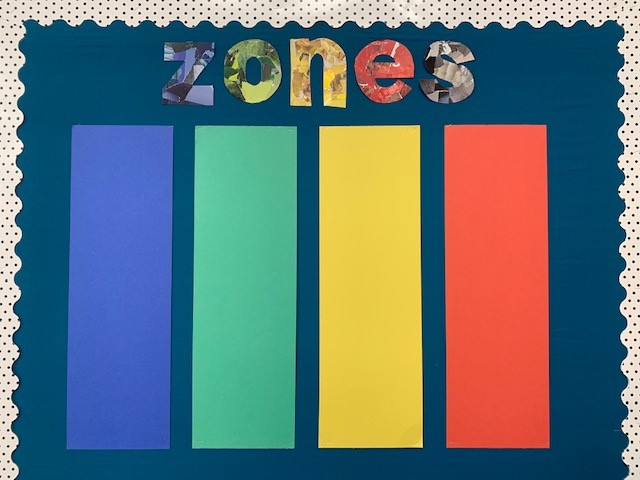This school year, every class at University Highlands will be participating in the Zones of Regulation curriculum (or just “Zones” for short). Students will be engaging in a variety of activities that are aimed at helping them gain skills in the area of self-regulation.
Self-regulation can go by many names, such as self-control, self-management, and impulse control. It is defined as the best state of alertness of both the body and emotions for the specific situation. For example, when a students plays on the playground or in a competitive game, it is beneficial to have a higher state of alertness. However, that same state could be a challenge in the library. The lessons and learning activities are designed to help students recognize when they are in the different Zones as well as learn how to use different strategies to change or stay in the Zone they are in. The four Zones are categorized by colour, and arranged from a state or lower alertness to highest alertness:
Blue, Green, Yellow, Red.

In addition to addressing self-regulation, students will gain an increased vocabulary of emotional terms, skills in reading other peoples’ expressions, perspective about how others see and react to their behaviour, insight into events that trigger their behaviour, calming and alerting strategies, and problem-solving skills.
A critical aspect of this curriculum is that all team members know and understand the Zones language. This creates a comfortable and supportive environment for the student to practice their self-regulation skills. It also helps the student learn the skills more quickly and be more likely to apply them in many situations. You can support during this learning process by:
- Using the language and talking about the concepts of Zones as they apply to you in a variety of environments–make comments aloud so the student understands it is natural that we all experience the different Zones and use strategies to regulate ourselves.
- For example, “This is really frustrating me and I feel like I’m going into the Yellow Zone. I need to use a tool to calm down. I will take some deep breaths.”
- Helping the student gain awareness of their Zones and feelings by pointing out your observations.
- Validating what Zone your student is in and helping them brainstorm expected ways to self-regulate so their behaviour is expected for the context.
- Sharing with the student how their behaviour is affecting the Zone you are in and how you feel.
- Helping the student become comfortable using the language to communicate their feelings and needs by encouraging them to share their Zone.
- Asking the student to frequently share their Zones learning–ask the student what their triggers and tools are, and ask them if they would like reminders to use the tools.
- Positively recognizing students for identifying their Zone and managing their behaviours while in it (instead of only pointing out when students are demonstrating unexpected behaviours whie in a Zone.)
It is important to note that everyone experiences all of the Zones–the Red and Yellow Zones are not the “bad” or “naughty” Zones. All of the Zones are expected at one time or another. The Zones of Regulation is intended to be neutral and not communicate judgement.